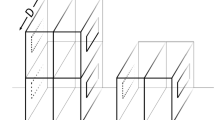Abstract
Recent studies show that the fluxes exchanged between buildings and the atmosphere play an important role in the urban climate. These fluxes are taken into account in mesoscale models considering new and more complex Urban Canopy Parameterizations (UCP). A standard methodology to test an UCP is to use one-dimensional (1D) off-line simulations. In this contribution, an UCP with and without a Building Energy Model (BEM) is run 1D off-line and the results are compared against the experimental data obtained in the BUBBLE measuring campaign over Basel (Switzerland) in 2002. The advantage of BEM is that it computes the evolution of the indoor building temperature as a function of energy production and consumption in the building, the radiation coming through the windows, and the fluxes of heat exchanged through the walls and roofs as well as the impact of the air conditioning system. This evaluation exercise is particularly significant since, for the period simulated, indoor temperatures were recorded. Different statistical parameters have been calculated over the entire simulated episode in order to compare the two versions of the UCP against measurements. In conclusion, with this work, we want to study the effect of BEM on the different turbulent fluxes and exploit the new possibilities that the UCP–BEM offers us, like the impact of the air conditioning systems and the evaluation of their energy consumption.







Similar content being viewed by others
Notes
To be precise, in the UCP of Martilli, it is possible to fix the internal building temperature, which accounts in some indirect and very rough way for the anthropogenic heat. But this technique is not precise, and does not allow any estimation of energy consumption.
References
Ashie Y, Thanh Ca V, Takashi A (1999) Building canopy model for the analysis of urban climate. J. Wind Eng. Ind. Aerodyn. 81:237–248
Best MJ, Grimmond CSB, Villani MG (2006) Evaluation of the urban tile in MOSES using surface energy balance observations. Boundary-Layer Meteorology 118:503–525
Bougeault P, Lacarrère P (1989) Parameterization of orography-induced turbulence in a mesobeta-scale model. Mon. Wea. Rev. 117:1872–1890
Christen, A. 2005. Atmospheric turbulence and surface energy exchange in urban environments. Results from the Basel Urban Boundary Layer Experiment (BUBBLE)—(gleichzeitig Diss. Phil.-Nat.-Fak. Univ. Basel 2005)—ISBN 3-85977-266-X
Clappier A, Perrochet P, Martilli A, Muller F, Krueger BC (1996) A new nonhydrostatic mesoscale model using a CVFE (Control Volume Finite Element) discretisation technique. In: Borell PM et al. (eds) Proceedings, EUROTRAC Symposium ’96, Computational Mechanics Publications, Southampton, pp. 527–531
Kikegawa Y, Genchi Y, Yoshikado H, Kondo H (2003) Development of a numerical simulation system toward comprehensive assessments of urban warming countermeasures including their impacts upon the urban buildings energy-demands. Appl Energy 76:449–466
Martilli A, Clappier A, Rotach MW (2002) An urban surface exchange parameterization for mesoscale models. Boundary-Layer Meteorology 104:261–304
Masson V, Grimmond CSB, Oke TR (2002) Evaluation of the Town Energy Balance (TEB) scheme with direct measurements from dry districts in two cities. J. Appl. Meteorol. 41:1011–1026
Oke TR (1987) Boundary layer climates, 2nd edn. Methuen, London, p 435
Oke TR (1988) The urban energy balance. Prog. Phys. Geogr. 12:471–508
Rotach MW, Vogt R, Bernhofer C, Batchvarova E, Christen A, Clappier A, Feddersen B, Gryning SE, Martucci G, Mayer H, Mitev V, Oke TR, Parlow E, Richner H, Roth M, Roulet YA, Ruffieux D, Salmond J, Schatzmann M, Voggt J (2005) BUBBLE—an urban boundary layer meteorology project. Theor Appl Climatol 81:231–261
Salamanca F, Krpo A, Martilli A, Clappier A (2009) A new Building Energy Model coupled with an Urban Canopy Parameterization for urban climate simulations—Part I. Formulation, verification and a sensitive analysis of the model. Theor Appl Climatol doi:10.1007/s00704-009-0142-9
Acknowledgements
We are particularly grateful to Andrea Krpo of the EPFL for the implementation of BEM in the UCP. The authors wish to thank CIEMAT for the doctoral fellowships held by Francisco Salamanca. We also thank Andreas Christen of the University of British Columbia for the important explanations about the input data used in the simulations. Moreover, we want to thank James Voogt of the University of Western Ontario who provided us the data about the indoor air temperature in some buildings obtained during the BUBBLE campaign, and finally Scott Krayenhoff of the University of British Columbia who sent us the thermal parameters corresponding to Basel-Sperrstrasse. This work has been funded by the Ministry of Environment of Spain.
Author information
Authors and Affiliations
Corresponding author
Appendix
Appendix
List of symbols
- C P (Jkg−1 K−1):
-
specific heat of the air at constant pressure
- COP :
-
energy efficiency (coefficient of performance)
- H sout (W):
-
sensible heat pumped out for cooling per building
- H lout (W):
-
latent heat pumped out per building
- L v (Jkg−1):
-
latent heat of vaporization
- q (kgkg−1):
-
specific humidity
- w (ms−1):
-
vertical component of the wind speed
- θ (K):
-
potential temperature
- ρ (kgm−3):
-
density of the air
Rights and permissions
About this article
Cite this article
Salamanca, F., Martilli, A. A new Building Energy Model coupled with an Urban Canopy Parameterization for urban climate simulations—part II. Validation with one dimension off-line simulations. Theor Appl Climatol 99, 345–356 (2010). https://doi.org/10.1007/s00704-009-0143-8
Received:
Accepted:
Published:
Issue Date:
DOI: https://doi.org/10.1007/s00704-009-0143-8




